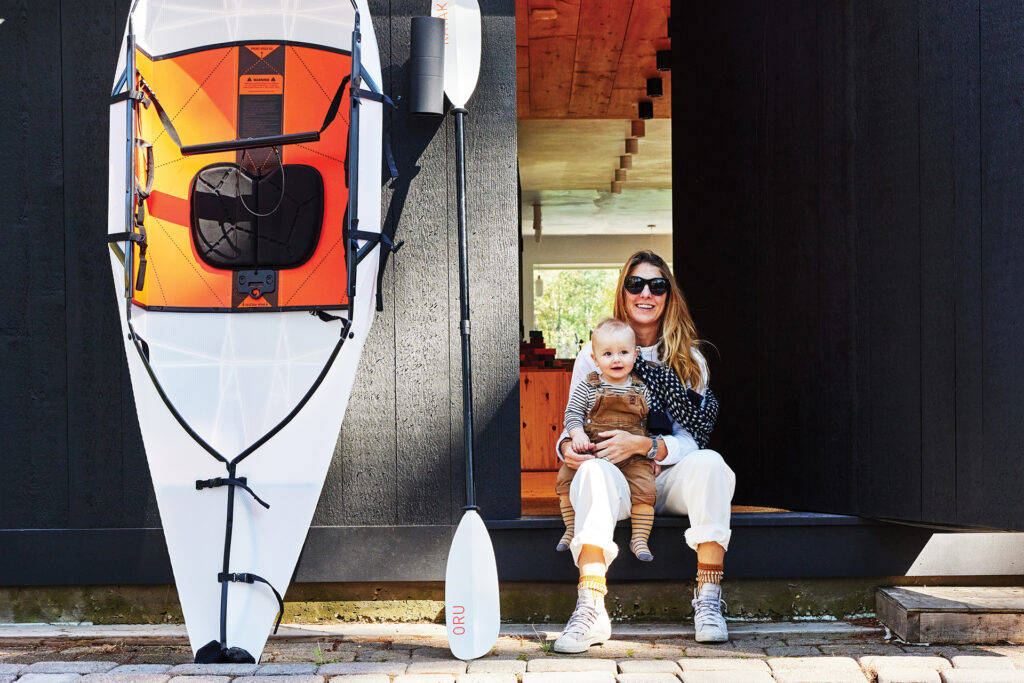The chic retailer’s success is only part of her story. How—and where—she lives is truly what makes her extraordinary. Enjoy.
By Jane Larkworthy
Photography by Natalie Chitwood
After designing four stores for a client base that’s both adventurous and stylish, Andrea Westerlind set about transforming her Ashley Falls, NY home to suit her impeccable taste—and she plans to make everything in it available to her customers.
Roughly 20 yards from Westerlind’s (stunning) front door, a line of railroad tracks hug the western edge of her property. They’re partially disguised, thanks to a smattering of trees and shrubs, and if you hadn’t noticed the official railroad crossing near her driveway’s entrance, you’d be forgiven for missing it entirely. But it’s still in use, all right, and Westerlind has the earplugs to prove it.
“It’s funny how the train never went by when we looked at this property,” laughs the Swedish native in reference to the long chain of freight cars that pass through on a seemingly loosey-goosey schedule. “The first time it was around 4am, and it really did feel like the train goes straight through your living room. But it’s a compromise. I used to live next to the Williamsburg Bridge, so I’m used to it.”
If that’s not enough of a quirk, consider that Westerlind’s property was once home to the former Ashley Falls Marble Quarry. When it closed in the ’50s, the 68-feet quarry was filled with water and a brick house was erected, followed by a second section two decades later. Judging from photos found on the Massachusetts MLS listing, the house appears to have remained in the ’70s until Westerlind and husband Gian Heilmann (Westerlind’s COO and CFO) saw its future through their Scandinavian eyes. They knocked down a few walls, covered the remaining ones with white plaster and added pine flooring and a ton of vast pane-less windows. What was once the garage door is now a ten-foot pivot-hinge front door which opens to a generously sized mudroom. Blonde woods cover kitchen appliances and rows of drawers flush with the walls in the bedrooms. And they excavated ten tons of marble during a septic inspection that now plays a pervasive role— as the kitchen’s stove vent and counterspace (where three stand-alone Pitt burners neatly reside), as both the flooring and shower walls in the primary bathroom, and, perhaps most dramatically, in the newly expanded patio and its adjoining stairs that lead to the property’s lake.
With a mane of dirty blonde hair and nary a stitch of makeup, Westerlind greets me one early fall evening wearing jeans and a navy sweater. I don’t even wear jeans but, nevertheless, I covet her entire look down to the beet-hued Arizona Eve Birkenstocks. When she explains that she’s third generation of a Swedish fashion house, I feel better, chalking it up to inheritance.
“I was kind of social as a kid, too, so sales came naturally,” she says. “Swedes are very shy so they’re reluctant to travel and, especially, to sell things.”
Westerlind, on the other hand, wanted to do both. She procured herself a visa by applying to Parsons’ fashion marketing program. Once there, she found an investor to help her open her own agency and good-bye Parsons, hello Fjällräven Kånken! The Swedish backpack brand recognizable by its cute curled-up Arctic fox logo had failed at cracking the US market, but Westerlind put her own spin on things. She created collaborations with Barney’s New York and Opening Ceremony and got the backpacks into the hands of Madonna and Sofia Coppola, who featured one in her film, Somewhere. Four years later, Westerlind sold the stateside division back to the company, which provided the resources to start her own. It was 2008 and she hadn’t even hit legal drinking age.
“I thought, I should just become the outdoor person of the fashion world,” she reflects as we walk the path that hugs that very deep lake. “Women didn’t wear backpacks or sneakers back then, so I made it my niche. Outdoors for urban people.”
Westerlind opened a few stores out west, but the back and forth to New York City became too much, so she searched closer to home and found her first location in Millerton, NY, the former home of Saperstein’s department store, which had shuttered its doors after a 71-year run. A second followed in Great Barrington, with Hudson and Kingston opening this past summer.
Along with outdoor everything from tents to hiking boots to ski suits, Westerlind’s inventory is expanding to indoor everything—specifically, everything in her home, from the wood shelving to the lighting by Modular Lighting Instruments that oversees its rooms and the Bari Hase wood stove that heats them. In December, prefab modular homes, starting at 100 square feet(!), will also be available.
“Super modern, super Swedish,” Westerlind says matter-of-factly. Just, please, don’t think of calling it luxury. “We stay away from that word,” she says. “Scandinavians love great quality, but for the basics that we wear every day and own for a long time. They have to make sense.”
We stop to gaze across the lake at her home, mirrored in the tranquil waters at dusk.
“I do think it’s a luxury to live in nature, though,” Westerlind says, then adds with a mild laugh. “Not having to wear high heels is a total luxury.”

Comments are closed.